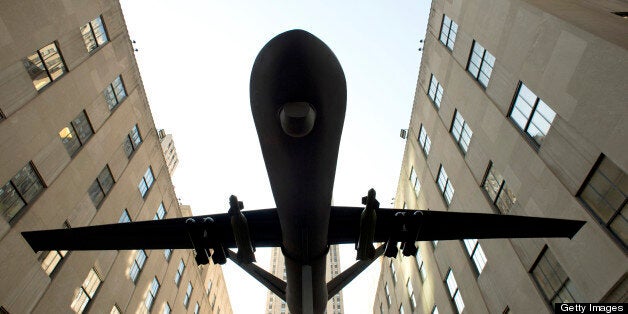
Recent media reports, including one in The New York Times, have stated that the Tsarnaev brothers who allegedly carried out the deadliest terrorist bombing in the U.S. since 9/11 during the Boston marathon learned how to build their pressure cooker bomb which killed three and maimed dozens of innocent bystanders online. Specifically, they referenced an online Al Qaeda periodical known as Inspire which had an article titled "How to Build a Bomb in the Kitchen of Your Mom." Eerily, in light of the way the April 15th bomb went off, Inspire told its online readers "The ideal location for a bombing is a place where there are a maximum number of pedestrian and the least number of vehicles. In fact if you can get through to 'pedestrian only' locations that exist in some downtown (city center) areas, that would be fabulous." It also stated "Go for the most crowded locations. Narrower spots are also better because it gives less chance for the people to run away." (see here for the Inspire magazine article titled 'Open Source Jihad' Section: 'America's Worst Nightmare -- Allows American Muslims to Train at Home') Inspire also had an article on pressure cooker bombs which stated "The pressurized cooker should be placed in a crowd and left to blow up. More than one of these could be planted to explode at the same time." (Two almost simultaneous bombs were used in Boston).
Inspire magazine also proved to be inspiration for Nidal Hassan, another American Muslim who went on a shooting spree in the U.S. army base at Fort Hood, Texas that left 13 dead in 2009. After Hassan's attack, Inspire proclaimed "Nidal Hassan is a hero." al-Awlaki's fiery preaching was also said to have inspired Faisal Shahzad the failed Times Square bomber.
But the story does not end there. As it transpires, Inspire was actually created and run by two American Muslims hiding out in remote Al Qaeda-controlled parts of Yemen who were able to reach out to English-speaking Muslims across the world. Their names were Samir Khan and Anwar al-Awlaki. Khan was a Pakistani American from New York who stated he was "proud to be a traitor to America," while al-Awlaki was a Yemeni-American from New Mexico who called Americans "devils" in his online publications. What made these two American Muslims so unique was that they had grown up in America, knew our society inside and out, and were able to mobilize disaffected American Muslims like the Tsarnaev brothers, Faisal Shahzad, and Nidal Hassan using vernacular English.
But al-Awlaki proved to be more than just the "Bin Laden of the Internet," he actively partook in plots that would have slaughtered many more Americans than the number that died on that tragic day in Boston had they succeeded. According to President Obama, "he took the lead in planning and directing efforts to murder innocent Americans." Specifically, Awlaki was actively involved in planning the December 25th, 2009 attempt to blow up a passenger-filled plane flying from Amsterdam to Detroit by the so-called "Underwear Bomber." He was also accused of being involved in attempt to blow up UPS and Fed Ex planes flying from Yemen using bombs that would be triggered by a cell phone. If this were not enough, he was found to have been plotting with a British Muslim of Bangladeshi descent to blow up a British airliner. In other words, al-Awlaki had become the new face of Al Qaeda terrorism.
For all these reasons the CIA and Joint Special Operations Command began to hunt al-Awlaki in his remote hideout in Yemen using their drones in 2010. In response to these extraordinary developments, al-Awlaki's father, Naseer al-Awlaki, sued CIA Director Leon Panetta and Defense Secretary Robert Gates with the support of the American Civil Liberties Union. The senior Awlaki described his son somewhat implausibly as an "All American boy." The ACLU lawsuit claimed that the Obama administration had given itself "sweeping authority to impose death sentences on American citizens."
Regardless of the lawsuit (which was thrown out by a judge), the CIA continued its hunt of al-Awlaki and Khan and, on September 30, 2011, the two American Muslims were tracked down and killed by a drone in Yemen. Their magazine Inspire stopped being published at the time and never recovered its online role as perhaps the greatest recruiter for Al Qaeda terrorism in the English-speaking world.
As these events unfolded I wrestled with the whole issue while writing a book on drones that aimed to provide the first history of the CIA's drone campaign in Pakistan, Yemen and Somalia. My instincts, as someone who was opposed to the invasion of Iraq, Gitmo, water-boarding etc. were initially to condemn the extrajudicial killing of an American, even a terrorist like al-Awlaki. I saw it as yet another step down the road towards the loss of civil liberties that had begun after 9/11.
But that was before the April 15th bombings in my hometown of Boston which profoundly changed my perspective. I can still recall the sickening feeling as we watched the runners go by on that bright day when panic began to spread on the porch of the race-side restaurant I was in as word of the attack spread. As the ambulances sped down the road towards the bomb blast with sirens blaring and the police frantically ending the race, I felt a sense of dread as I recalled friends of mine who were closer to the bomb site than me, cheering on runners at the finish line. I tried calling my friends but the cell phone reception had been turned off by the Boston police to prevent potential cell phone-activated bombs from going off.
While my friends ultimately emerged (physically) unscathed, the horrific images I saw that night on the Internet (most of which did not make it into the mainstream press, thank God) of a bomb victim being wheeled away from the blast sight, staring in horror at the sight of the bloody stumps of his legs will remain with me forever (Google search images of the 'Boston bombing victims' to see uncensored, bloody images of maimed survivors of the bomb blast to see the human toll the bombs took, but be forewarned -- they are horrific). I also remember the fear that swept Boston when this major metropolis later went on lockdown as the surviving terrorist was hunted down and captured after a deadly gunfight.
These terrorizing events not only made me feel helpless, but reminded me that we live in a world where terrorists are actively plotting further carnage and mayhem here in the USA. I had not felt this sense of powerlessness since 9/11. I wanted to strike out at those who had brought terror to my town on that day. Then I recalled that that is exactly what is going on in the remote regions of Pakistan and to a lesser extent Yemen. The weapons that terrorize the terrorists the most are the aptly named Predator and Reaper drones that killed al-Awlaki and Khan. These remote control hunters are engaged in the largest assassination campaign since the Vietnam War in their hunt for terrorists who are hiding out in remote Pakistani and Yemeni lands where they cannot be apprehended.
I don't know if the drones could have prevented the April 15th bombing in Boston had they killed al-Awlaki before he posted his motivational journal article on "How to Build a Bomb in Kitchen of Your Mom?" But in my research for my book I had uncovered cases where drones did actually kill terrorists who were actively engaged in plotting mass casualty terrorism on a scale far greater than the Boston bombings. Civilians' lives were saved by the drone strikes which killed the plotters.
Take for example the 2010 plot to carry out a Mumbai-style urban terror assault on cities in France, Germany and Britain by a group of Al Qaeda-linked British and German Muslims training in the remote tribal zones of Pakistan. A captured member of the group told the CIA "They were going to attack multiple centers in Europe over a few days. They were going to shoot the hell out of people, terrorize them." It would have been the carnage of Boston, only on a truly massive scale. That was until the CIA's spy networks found the bombers and the drones systematically hunted them down and killed the British Muslim terrorists and the German Muslim terrorists.
Or take the example of the Pakistani Taliban terrorist Qari Hussain known as the Ustad e Fedayeen (Teacher of Suicide Bombers) whose bombers slaughtered up to 3,000 Pakistani civilians last year in a slow motion version of 9/11. When the drones killed him, Pakistanis understandably celebrated and some actually thanked the U.S. If you don't believe me go to the following Pakistani newspaper and scroll down to the Reader Comments section at the bottom which features such comments as "If this news [of Qari Hussain's death] is true then God Bless America and God Bless the drones. He blew people into pieces and he got blown into bits and pieces. Good riddance!"
In my research I uncovered literally hundreds of similar cases where terrorists with blood on their hands were tracked down and killed by drones, thus potentially saving scores of civilians who were the intended targets of their mayhem. For a website devoted to profiling high-ranked terrorists who have been killed by drone strikes see the Long War Journal. According to this widely respected source, which monitors each and every drone strike in Pakistan, "Since 2006, there have been 2,507 leaders and operatives from Taliban, Al
While there is no such thing as an excusable killing of a civilian, whether it be an accidental "collateral damage" death in a CIA drone strike or an intentional killing of civilians in the sort of terrorist bombings that have become a regular occurrence in Pakistan, these statistics, and the constant pressure to prevent further terror acts on American soil, somewhat mitigate the harm caused by the CIA's controversial drone assassination campaign. These stats also help explain why President Obama, whose first major foreign speech was to the Muslim world in Cairo, Egypt in 2009 promising a new era of understanding, has nonetheless ramped up the drone campaign in Pakistan and Yemen that was bequeathed to him by President Bush. Simply put, he cannot allow a major terrorist strike like the bloody 7/7 bombings in London (which were planned in Pakistan's tribal zones) or the liquid bomb plot (a plan to blow up numerous airliners using liquid bombs that was planned in Pakistan's tribal areas where the drones operate) on his watch. While I still fear the radicalizing effect that the deaths of those 153 innocent Pakistanis may have on their surviving kin, having seen the tremendous impact that the first terror bombing on U.S. soil since 9/11 had on my town I am a little more tolerant of the drone strikes as a preemptive counter-terrorism policy than I was before the events of April 15th.
For a history of the CIA's murky drone assassination campaign in Pakistan, Yemen and Somalia see Brian Glyn Williams' Predators. The CIA's Drone War on Al Qaeda.
